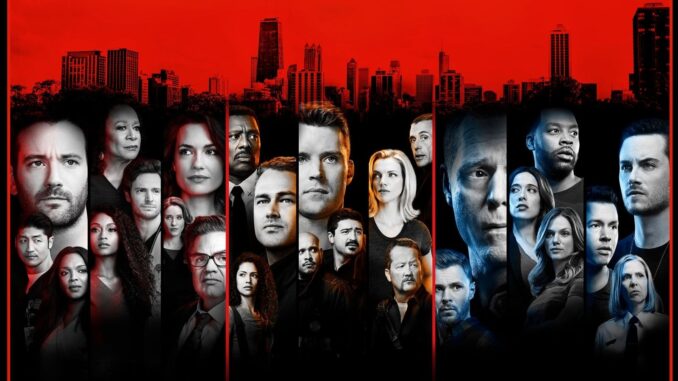
The One Chicago franchise is like a family dinner with your favorite dishes: Chicago Fire, Chicago Med, and Chicago PD bring different flavors, yet they’re undeniably connected. This fall, they pulled off something bold and fascinating—all three finales revolved around the same core storyline. But here’s the twist: each show added its unique spin, making fans buzz with excitement.
So, what’s the secret sauce? Let’s dive into how they told one story in three distinct ways, dissect their brilliance, and explore why this formula keeps viewers hooked.
What Is One Chicago?
Let’s back up a bit for those new to the One Chicago universe. Created by the legendary Dick Wolf, this franchise features interconnected dramas based in Chicago:
- Chicago Fire: Heroic firefighters and paramedics.
- Chicago Med: Life-and-death decisions in a hospital.
- Chicago PD: Gritty police work on the city streets.
These shows weave their narratives together, often crossing paths with shared characters and stories.
The Shared Plotline: A High-Stakes Rescue
This season, all three finales centered on the theme of rescue under pressure. Whether it was saving a life, unraveling a mystery, or preventing disaster, the underlying question was the same: How far will you go to protect those you care about?
Chicago Fire: Heart-Pounding Heroics (H2)
Chicago Fire delivered the most literal interpretation of the rescue theme.
The Setup
A catastrophic factory fire trapped several workers, leaving Squad 51 in a race against time. The stakes? Explosive chemicals that could level the building.
The Execution
Fire’s hallmark action scenes didn’t disappoint. You could almost feel the heat as the team navigated collapsing floors and limited oxygen supplies. But amidst the chaos, the emotional core shone: characters risking their lives not just for duty, but for each other.
Chicago Med: The Emotional Rescue (H2)
Med tackled the storyline differently—through an emotional lens.
The Setup
A young patient’s life hung by a thread, and the doctors faced a near-impossible ethical dilemma. The rescue here wasn’t physical—it was about making the right decision under crushing pressure.
The Execution
Med’s strength lies in its humanity, and this finale leaned into it hard. Watching Dr. Halstead and Dr. Choi clash over treatment plans was gut-wrenching, but it highlighted the emotional toll of life-or-death decisions.
Chicago PD: A Gritty, Twisted Rescue (H2)
PD brought the grit, as usual, tackling the rescue story with a dark, criminal edge.
The Setup
A kidnapping case spiraled out of control, leading to a chilling race against the clock. The victim? A key informant in a major drug bust.
The Execution
Voight’s team took no prisoners—literally and metaphorically. The finale dived deep into the moral gray areas of law enforcement, forcing characters to confront their own limits. The “rescue” wasn’t just about saving a life; it was about protecting justice.
How Each Show’s Take Stands Out (H2)
The beauty of this shared storyline lies in its versatility. Each show honored its unique identity while staying connected to the broader theme.
Chicago Fire’s Strengths (H3)
- Action-packed sequences.
- Emotional camaraderie.
- High physical stakes.
Chicago Med’s Edge (H3)
- Moral dilemmas.
- Character-driven drama.
- Emotional depth.
Chicago PD’s Bold Choices (H3)
- Gritty storytelling.
- Ethical ambiguity.
- Tense, high-stakes action.
Why This Formula Works for One Chicago (H2)
The shared storyline approach isn’t just a gimmick—it’s a storytelling masterstroke. Here’s why:
- Familiarity Meets Freshness: Fans love consistency, but they crave variety too.
- Interconnected Universes: The overlap keeps viewers invested across all shows.
- Thematic Depth: Tackling the same story from different angles adds layers of complexity.
Behind the Scenes: Crafting a Unified Finale (H2)
Pulling off such a cohesive narrative requires a ton of collaboration. Writers across all three shows work closely to ensure the stories align without feeling repetitive.
The Challenges (H3)
- Balancing unique tones.
- Avoiding plot holes in crossovers.
- Maintaining character integrity.
The Payoff (H3)
When done right, as it was this fall, the result is storytelling magic.
Fan Reactions: Social Media Buzz (H2)
If there’s one thing One Chicago fans love, it’s debating finales on Twitter and Reddit. Reactions ranged from “heart-pounding perfection” to “why do they always end on a cliffhanger?!”
What’s Next for One Chicago? (H2)
With the fall finales wrapped, what’s next for our favorite heroes?
- Will Fire address the fallout of their daring rescue?
- How will Med’s team handle the emotional scars?
- Can PD’s Voight continue walking the moral tightrope?
Lessons Learned from the Fall Finales (H2)
The biggest takeaway? Stories don’t have to be unique to be compelling. It’s all about execution—and One Chicago nails it every time.
Conclusion
The One Chicago fall finales were a storytelling masterclass, proving that one story can be told in three wildly different ways. From heart-pounding action to moral dilemmas and gritty rescues, each show brought something unique to the table. This formula keeps fans coming back, reminding us why we love the One Chicago universe.
FAQs
1. What makes One Chicago’s storytelling unique?
The interconnected narratives allow for overlapping storylines while retaining each show’s individuality.
2. Do I need to watch all three shows to understand the finales?
Not necessarily, but watching all three enhances the experience.
3. How do the fall finales set up the next season?
Each finale leaves threads that will shape the characters and stories moving forward.
4. Why do fans love the shared plotline concept?
It creates a sense of unity while offering fresh perspectives from each show.
5. What’s the best order to watch One Chicago?
Follow the broadcast schedule to enjoy crossovers seamlessly!
